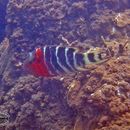Diagnostic Description
provided by Fishbase
This species is distinguished by the following characters: body moderately deep, its depth 2.35 to 2.6 times in standard length; dorsal profile of head convex; anterior tip of snout forming an acute angle; jaws prominent, especially lower jaw in large individuals; strong canines 2, situated anteriorly in each jaw; no enlarged tooth present on rear of upper jaw; D IX,10, continuous with spines and anterior soft rays of similar length; A III, 8; pectoral fins with ii unbranched and 10 branched rays; pelvic fins short, not reaching anus; caudal fin rounded in juveniles, the upper and lower rays forming elongate lobes in large individuals, giving the fin a trilobed appearance. Lateral line interrupted below posterior portion of dorsal-fin base, with a total of 22-23 pored scales; scales reaching well onto bases of dorsal and anal fins; scales in front of dorsal fin extending forward to above anterior portion of eye; cheek and opercle scaly; lower jaw without scales (Ref. 9823). Colour of juveniles brown with 5 white bars across body, the first broadest and brightest, below third dorsal-fin spine, the second bar indistinct, on ventral half of body and the fifth is faint, anteriorly on caudal peduncle; all bars but the second extend onto dorsal and anal fins; 3 faint, short, greenish bars on nape and interorbital space; short, oblique, white or yellowish band from eye across preopercle; narrow white bar at base of caudal fin; large, dark blue spot, surrounded dorsally with orange, anteriorly in dorsal fin. Colour of subadults and females with similar white bars on nape and body as juveniles, but the second bar on lower body becoming more distinct and nearly reaching dorsal fin; there are few scales behind eyes and many scales on body with vertical indistinct dark streak; an orange area from behind eye and nape to pectoral-fin base; humeral area with 2 (sometimes a third above) double, rounded to nearly quadrangular, dark blue or black spots; head becoming olive with short orange-red lines radiating from eye; the lower body, dorsal and anal fins, and posterior half of caudal fin with small dark orange to red spots, only a few spots in fins in some individuals, sometimes median fins also with short red lines, similar to those radiating from eye; caudal fin is white with black bar in centre (bar not reaching upper and lower margins) and black posterior margin. Colour of males with similar color pattern but the suffusion of orange becoming bright orange-red, covering postorbital part of head, anterior of body (including anterior abdomen and chest), and pectoral-fin base, the area restricted posteriorly to the first white bar, not enclosing it; a second white bar across the body reaching dorsal fin; black streak on scales becoming broader and well-defined (Ref. 117607).
- Recorder
- Estelita Emily Capuli
Life Cycle
provided by Fishbase
Oviparous, distinct pairing during breeding (Ref. 205).
Morphology
provided by Fishbase
Dorsal spines (total): 9; Dorsal soft rays (total): 10; Analspines: 3; Analsoft rays: 8
- Recorder
- Estelita Emily Capuli
Trophic Strategy
provided by Fishbase
Inhabits lagoon and seaward reefs, usually in areas with mixed coral, sand, and rubble. Feeds mainly on benthic, hard-shelled invertebrates, including mollusks, crustaceans and sea urchins.
- Recorder
- Drina Sta. Iglesia
Biology
provided by Fishbase
Adults inhabit lagoon and seaward reefs, usually in areas with mixed coral, sand, and rubble (Ref. 9710). Young common on silty reefs, usually along edges with algae-rubble and sand (Ref. 48636). Juveniles are secretive. Individuals often solitary and mainly on sand and rubble substrata near coral reefs, but more common in protected than exposed areas, generally at depths less than 20 m. (Ref. 117607). Feed mainly on benthic, hard-shelled invertebrates, including mollusks, crustaceans and sea urchins (Ref. 5374). Oviparous, distinct pairing during breeding (Ref. 205). Caught on hook-and-line with some frequency, this species is marketed in small numbers. Occasionally seen in the aquarium trade (Ref. 9823).
- Recorder
- Estelita Emily Capuli
Importance
provided by Fishbase
fisheries: minor commercial; aquarium: commercial; price category: very high; price reliability: very questionable: based on ex-vessel price for species in this family
- Recorder
- Estelita Emily Capuli
分布
provided by The Fish Database of Taiwan
分布於印度-太平洋區,由紅海及東非到密克羅尼西亞及薩摩亞,北至日本琉球與台灣。台灣除西部外,各地海域皆有分布。
利用
provided by The Fish Database of Taiwan
中大型之隆頭魚,體色鮮艷,常被當作觀賞魚,亦是高級食用魚,肉質帶有膠質,很適合紅燒。以延繩釣或一支釣較容易上鉤。
描述
provided by The Fish Database of Taiwan
體延長而呈長卵圓形;體高約等或稍長於頭長;頭部背面輪廓圓突。口中大,前位,略可向前伸出。鼻孔每側
2個。吻長,突出;下頜較上頜突出,成魚下頜尤明顯;上下頜各具錐形齒一列,前端各有一對大犬齒。前鰓蓋骨邊緣具鋸齒;左右鰓膜癒合,不與峽部相逢。體被大形圓鱗;背側部側線與體背緣平行而略彎,後段在背鰭鰭條基部後下方中斷。D.
IX, 10;A. III, 8;P. 12;L.l. 14-15;G.R.
5-7+7-9;背鰭連續;幼魚尾鰭圓形,成魚之上下緣則呈絲狀;成魚腹鰭第一軟條不延長而向後達肛門。體白色或粉紅色,頭部紅橙色,吻及頭背黑褐色;體側具七條寬的黑色橫帶,各鱗片具黑橫紋;各鰭白色或粉紅色,體側橫帶延伸至背、臀鰭中央,尾鰭中央具一黑橫帶,鰭緣黑色。
棲地
provided by The Fish Database of Taiwan
主要棲息於沿岸珊瑚礁海域或礁石旁的沙地上,深度範圍從水深5-60公尺。以底棲性硬殼的無脊椎動物,包括軟體動物、甲殼類和海膽等為食。
Red-breasted wrasse
provided by wikipedia EN
- license
- cc-by-sa-3.0
- copyright
- Wikipedia authors and editors
Red-breasted wrasse: Brief Summary
provided by wikipedia EN
The red-breasted wrasse (Cheilinus fasciatus) is a species of wrasse native to the Indian Ocean and the western Pacific Ocean.
- license
- cc-by-sa-3.0
- copyright
- Wikipedia authors and editors
Description
provided by World Register of Marine Species
Occurs on corals reefs and in sandy areas near reefs. Feeds mainly on benthic, hard-shelled invertebrates, including molluscs, crustaceans and sea urchins (Ref. 5374).
Froese, R. & D. Pauly (Editors). (2023). FishBase. World Wide Web electronic publication. version (02/2023).
- license
- cc-by-4.0
- copyright
- WoRMS Editorial Board


